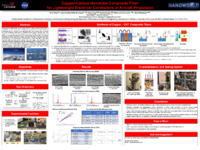Copper-Carbon Nanotube Composite Fiber For Lightweight Electrical Conductors in Aircraft Propulsion
Main Article Content
Abstract
By Nhat Phan, Chemical Engineering
Advisor: Vesselin Shanov
Award: Excellence in Research Communication
Presentation ID: 80
Abstract: Replacement of traditional propulsion systems with Electrified Aircraft Propulsion (EAP) is needed to overcome issues with emissions due to fossil fuels, and noise levels in commercial transport aircrafts. Current generation EAP`s uses a huge amount of copper for power distribution, which limits the performance due to great heat losses and high weight. To enhance the efficiency of motors, generators, and other electrical systems in EAP`s, we are exploring copper-carbon nanotube (Cu-CNT) composite fibers as electrical conductors for power distribution. Carbon nanotube (CNT) fibers were spun from CNT arrays grown in a chemical vapor deposition (CVD) process. The fibers were then decorated with palladium before coating them with copper. The combination of electroless deposition of palladium and double electrodeposition of copper proved to play a key role to avoid copper dendrite growth thus contributing to the higher electrical conductivity of the composite fibers. With properties such as high tensile strength, good electrical conductivity, light weight, and scalability in production, Cu-CNT composite fibers are a very good alternative to pure copper wires in EAP`s.
